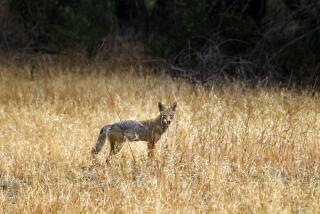Fur Trappers Living by the Skin of Their Teeth
- Share via
WISDOM, Mont. — Along the Big Hole River the fur grows long, thick and glossy during the harsh winters (it was 52 below zero last Christmas). It no longer draws premium prices, though, and trapper Al Klasen’s 60-year-old fascination with fur is ebbing fast.
“All fur is bad,” said Klasen, shrugging his shoulders, his face showing years of work in the snow and cold. “The fur houses, Seattle and Hudson Bay, are filled with fur. There’s just no market.”
“It’s them damn animal-rights people,” added his wife, Tina.
Whatever the reason--a fur glut, changing styles, social pressure against wearing skins--Klasen looks at the bottom line and sees fur trapping going the way of drive-in movies.
The pelts of 126 coyotes Klasen trapped last winter sold for $15 each in March. “That was an insult,” said Tina.
Eight years ago, similar pelts fetched as much as $135.
Silver fox, worth $250 six years ago, is now $25 “if you’re lucky,” said Klasen. For a bobcat, $85 is tops “but it was $300 to $400,” Klasen said.
Sitting in a room with pelts from dozens of animals and big-game trophies staring down from the walls, the 71-year-old outdoorsman talked of a trapping career that supported him and his family for more than half a century.
In recent years, fur has become supplemental income to the couple’s small motel and Klasen’s logging.
Not long ago, their fur farm was bustling with 2,000 minks, scores of foxes, a few bobcats, even some rabbits.
Now the fur barn is nearly empty and hundreds of cages are piled in a corner of the 20-acre farm. Klasen sets his trap lines fewer and closer to home because fur prices won’t buy enough gas to reach the high country.
Six years ago, Klasen sold 700 mink pelts for $35,000. Two years ago, the price was so low he pelted more than 1,700 mink--killed and skinned them--took the check for $12,000 and went out of the mink business. With the business went his dreams of supplemental retirement income.
“I thought there was a mistake with the check,” Tina Klasen said. “I just cried.”
Mink farmers say it now may cost $32 to produce a prime pelt that will sell for no more than $22. And that’s up from around $17 last year.
Klasen blamed some of the problem on “a public-relations failure.” As the animal-rights movement pressed its campaign against fur fashions, “there was nobody out letting people know the truth about animals,” Klasen said.
“The animal-rights people aren’t out where the animals are,” Klasen said. “They don’t see what lots of coyotes do to the antelope and deer--hamstringing and pulling them down.”
Klasen said the animals he raised for fur were treated humanely. The better they fared, the better their pelts and the bigger the check, he said.
His philosophy of trapping for wild furs was simple: Harvest only the surplus. “You always leave some seed stock,” he explained.
Helen Jones of Clarke Summit, Pa., isn’t concerned about Klasen or thousands of other trappers like him. She is president of the International Society for Animal Rights.
“The whole idea of taking animals, capturing them and killing them for fur for fashion is obscene,” she said.
“There’s complete unity that fur must go. We began to win the battle when we concentrated on fur and the consumer,” she said. “It’s wrong to buy or wear fur because of the suffering involved.”
But animal activists haven’t hurt the industry as much as they think, said Doug Judkins of the Bridger Fur Co. in south-central Montana.
“There are people still buying fur coats, and you don’t have to be a millionaire to have one anymore. There’s just way too much fur out there. Until that stock gets used up, we’re going to see low prices,” the fur buyer said.
Still, Judkins is hurting.
In 15 years, his company has shrunk from a concern supporting six families to a part-time operation fully supporting no one.
“I’m a buyer, and I can’t make a living at it,” he complained. “It costs you as much to ship some of the furs as they’re worth.”
Larry DiLulo of Great Falls, Mont., deals in pelts for Pacific Hide and Fur, which has 31 stores in six Western states. He says that some furs can’t even be given away.
“Muskrats were $5 to $6, but now are 50 cents to $1. Our overhead stays the same, so what can you make on a 50-cent rat?” DiLulo asked.
“Animal-rights people, to a certain extent, have changed attitudes,” he added. “A handful of people are intimidating a nation.”
The fur trader says those demanding an end to the killing of animals for fur have not considered the consequences.
“What are you going to do with the animals?” he asked. “They are not going to stop producing, stop breeding. You’re either going to have to control the human population or the animal population, because there’s not enough room for everything to go unchecked.”
Judkins agreed. He said the coyote population, for example, is increasing rapidly because prices are so weak that hunters and trappers won’t go after them.
“They’re going to be so thick that disease will be rampant. That’s what some of these animal-rights people don’t realize.
“A trapper actually is a conservationist,” Judkins said. “Mother Nature is a lot more cruel than a trapper.”
More to Read
Sign up for The Wild
We’ll help you find the best places to hike, bike and run, as well as the perfect silent spots for meditation and yoga.
You may occasionally receive promotional content from the Los Angeles Times.






